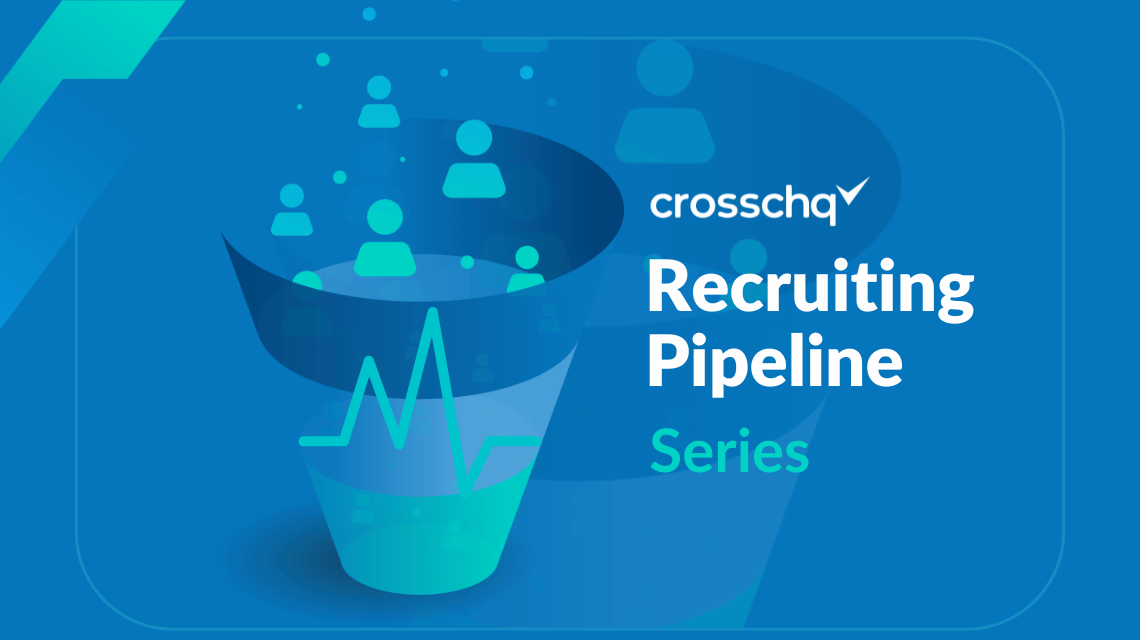

Crosschq Blog
The Recruitment Pipeline From The Candidate's Point Of View

When it comes to recruitment, visibility into the hiring funnel is critical for recruiters and hiring managers. What does your pipeline look like from the candidate’s point of view (POV)?
Making sure the candidate's experience is matching up with the recruiter's and hiring manager's experience with the talent pipeline is one of the most important steps when trying to align actual recruiting practices with business hiring objectives.
By looking at your recruitment process from the candidate’s point of view, you can gain a better understanding of how candidates are perceiving your hiring practices, and what they are assuming about your internal processes.
This makes it easier to figure out how you’re seeing greater than anticipated drop-off at key points in the recruiting funnel, why the candidates you want most keep slipping out of your grasp right when you are ready to seal the deal, and what you need to do to improve Quality of Hire.
Job Descriptions
The first stage of recruitment is deciding how to present the job to potential applicants. In a competitive labor market, job descriptions can be critical for attracting top talent. In more cross markets, they are just as critical for clarifying job requirements so no one ends up wasting time.
Recruiter/Hiring Manager POV
Job descriptions are now marketing materials. They need to give as much information as possible, packaged to make the position seem attractive to the right demographic. This can lead to descriptions that:
-
Double down on every single skill the “dream candidate” would know, making it close to impossible for a candidate to feel qualified.
-
Don’t deliver on a true description of the role, using quirky terms or “jargon” that don’t really tell candidates what the job is.
-
Leaving out important information completely, such as expected work hours and pay, could lead to lots of misunderstandings and disappointments on both sides.
Candidate POV
Candidates look at job descriptions and want transparency. It’s all right if every scrap of information isn’t present, but a salary range benefits list, and expected work location and schedule are near the top of the list, right before top requirements and expectations, and right after a clear, concise job description that encapsulates the role.
Applicants aren’t “passionate about polyurethane floor coatings. They aren’t interested in achieving their lifelong dream of being a “marketing unicorn” or a “social media guru.” However, they might want to apply to “sell software to digital marketing firms” or “create interactive social content for a pediatric dental practice.”
Pro-Tip: Research shows that men will go ahead and apply for a job even if they only have 60% of the qualifications, but women won’t apply unless they can check off 100% of those “quals” boxes. Go back through the list of requirements, and look for things that can be readily learned during training or on the job. These can be moved out of “requirements” and into a “bonus skills” section. Additionally, remove gendered language from your job ads and add in a few words about your DEIB commitment.
Application Steps
If you are committed to building a modern, top-performing recruiting pipeline, automation and data analytics are core concepts you need to embrace. However, relying too heavily on automation and filters can backfire when it comes to making recruiting decisions.
-
Applicant Tracking System (ATS) filters that are too restrictive can mean you exclude top talent that could be improving diversity and bringing innovation to your company.
-
Extra-heavy reliance on automation too deep in the hiring funnel can start to feel impersonal and turn candidates off.
-
Demands for multiple assessments and tests immediately upon application can make high-quality candidates feel that their time is being disrespected.
Recruiter/Hiring Manager POV
Recruiters and hiring managers are busy people. The administrative work that goes with the job can feel overwhelming. This means automation is a must, and that using all data tools available, including filters on your ATS, should be your go-to. These tools plus pre-hire assessments and tests can help you reduce a large field of applicants to a more reasonable number. However, you can’t rely on full automation to deliver top talent.
Candidate POV
Today’s job candidate wants to be able to apply for a job quickly and easily, with as few steps as possible. They also want a chance to stand out and catch your attention. Make sure your hiring funnel makes applying easy and free from exclusionary bias.
In 2020, 61% of job applications were made by job seekers via their mobile devices, and 66% of candidates have expressed a willingness to have a chatbot guide them through the initial steps of an application.
Pro-Tip: Streamline the top of your hiring funnel with an easy, app-driven, and mobile-friendly application process. Additionally, feel free to use pre-hire assessments, but keep the number of demands to a minimum and don’t rely on them too heavily for decision-making (one common assessment has been found to score candidates highly, who then fail to deliver on Quality of Hire expectations.)
Interviewing Stage
Getting candidates in for interviews is one of the immediate challenges faced by recruiters. Conducting interviews that deliver information that can be used for decision-making is one of the biggest challenges for hiring managers.
Recruiter/Hiring Manager POV
Recruiters want to get candidates scheduled for interviews, and hiring managers want interviews to yield high-value information they can use to clearly identify front runners. However, this is the stage where things can easily go awry:
-
Disconnects between recruiters and hiring managers can result in misalignment and the wrong candidates being passed through to the interview stage.
-
Poor interviewing techniques or lack of interviewing experience can result in a lack of information resulting from interviews.
-
Problems and delays with interview scheduling can result in the loss of high-value candidates.
Candidate POV
It’s an unwelcome truth that 60% of recruiters say they regularly lose candidates who are tired of waiting for an interview to be scheduled. This means all of the work that went into sourcing and selecting these candidates has been a loss, increasing the overall cost of hiring for the role. Candidates who are going to be offered an interview need to be notified immediately, and an accurate time frame is provided for when they can expect this to happen.
Additionally, the interview process itself is a two-way street. Candidates who have a poor experience in an interview are less likely to accept even an attractive offer. Interviewers and candidates who don’t “click” can prevent a high-quality applicant from even making it to the final round, but multiple interview rounds can lengthen the time to hire, causing candidate attrition.
Pro-Tip: Train someone to act as a lead interviewer for your company (accuracy in hiring the right person increases with interviewer experience) and use a collaborative interviewing approach to cut down on unconscious bias and shorten the time between the interview and offer. Additionally, use scheduling software to help get everyone concerned in a room at the same time faster and more efficiently.
By thinking about what your candidates are experiencing at each stage of the hiring funnel, you can improve communication, engagement, and candidate experience. Ultimately, the goal is to shorten and streamline the hiring process, without sacrificing Quality of Hire.
-
TalentWall™ by Crosschq shows where applicant drop-off is occurring, how diverse your pipeline is, and when high-value candidates have been left too long without engagement.
-
Crosschq 360 takes traditional reference checking and transforms it, making it possible to obtain plenty of information on candidates and their skills to drive better hiring decisions.
-
Crosschq Analytics makes it easy to develop surveys that can measure candidate satisfaction rates among new hires, and guide future recruitment strategies.
To learn more about how Crosschq can help you create great candidate experiences, contact us for a free demo today.
Take the Guesswork
Out of Hiring
Schedule a demo now



%20-200x43.png)






